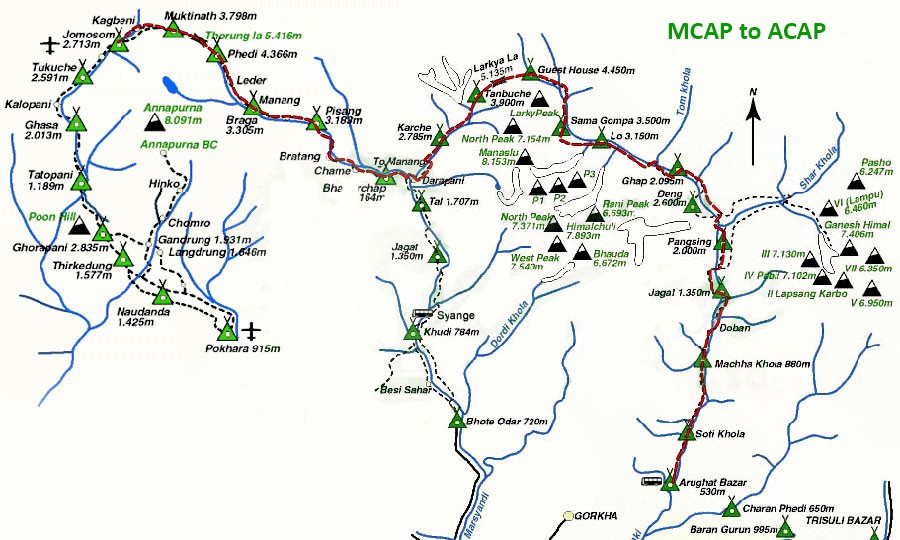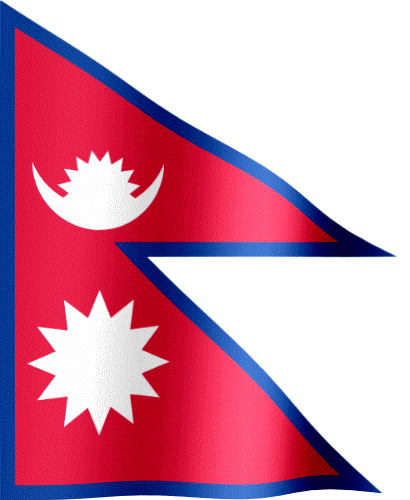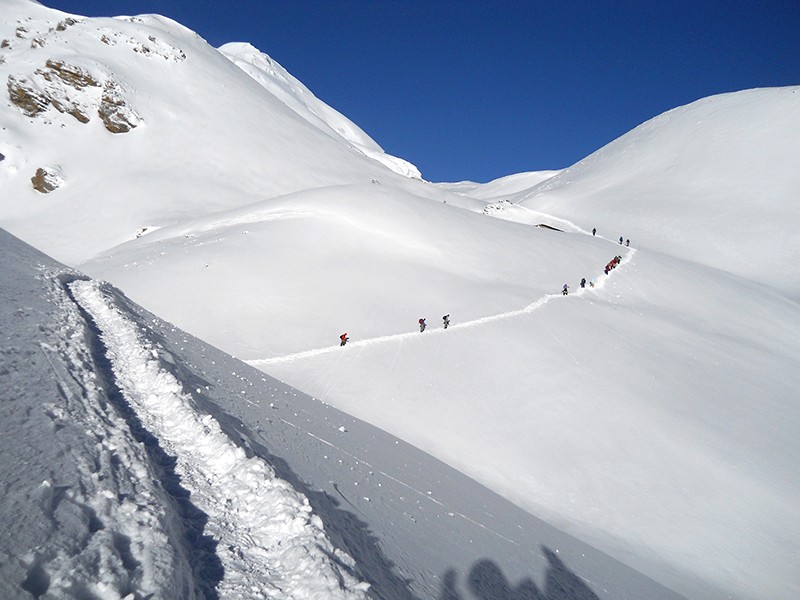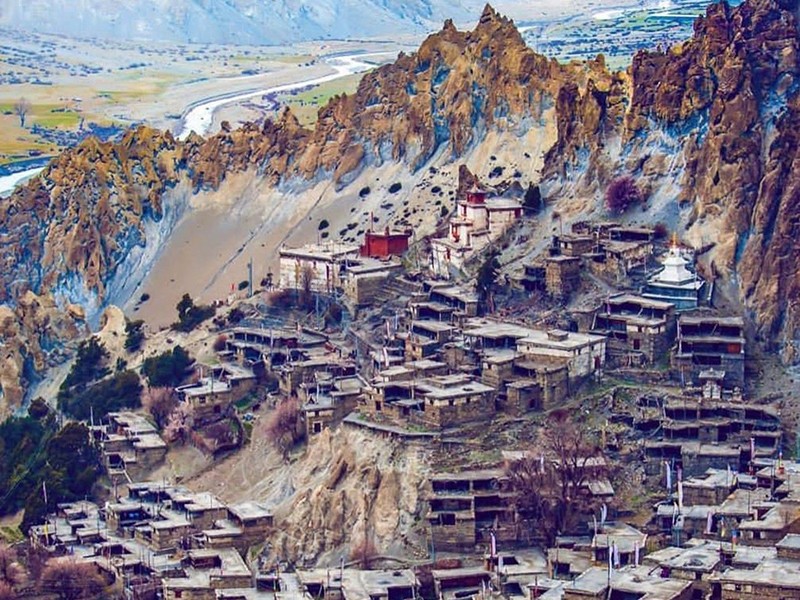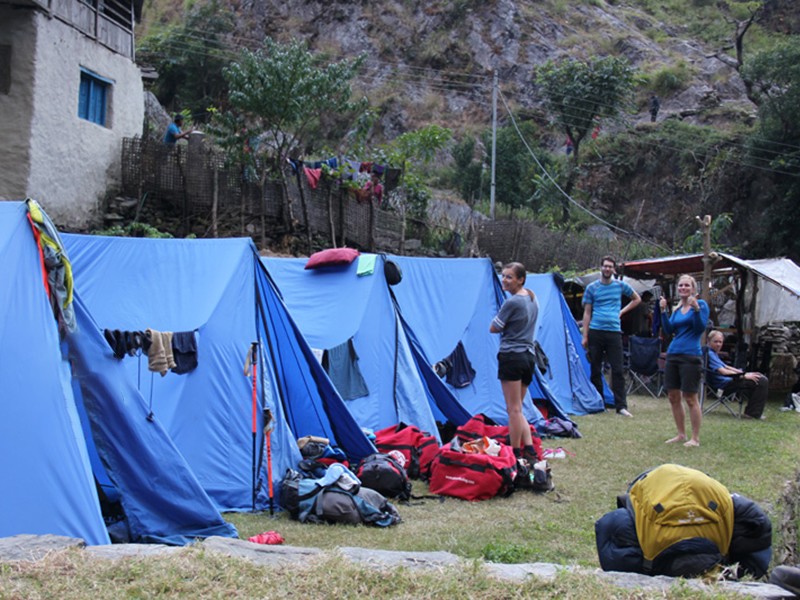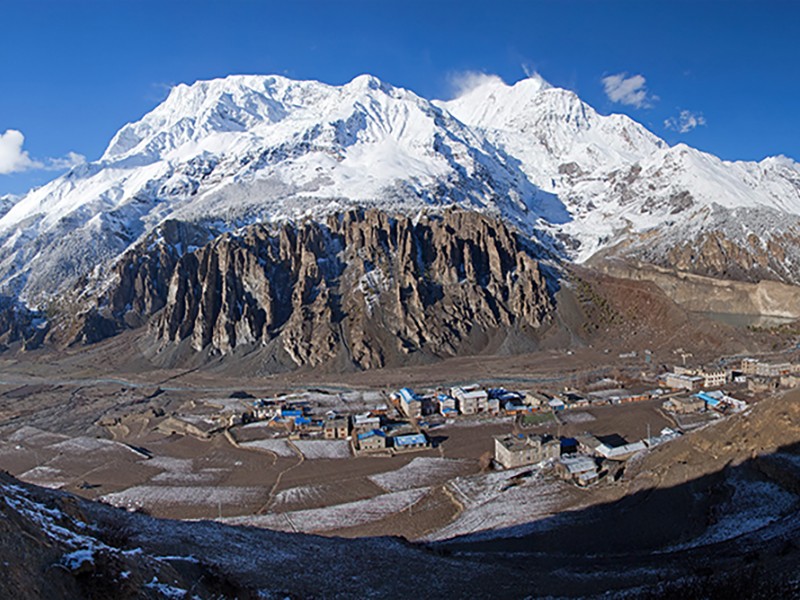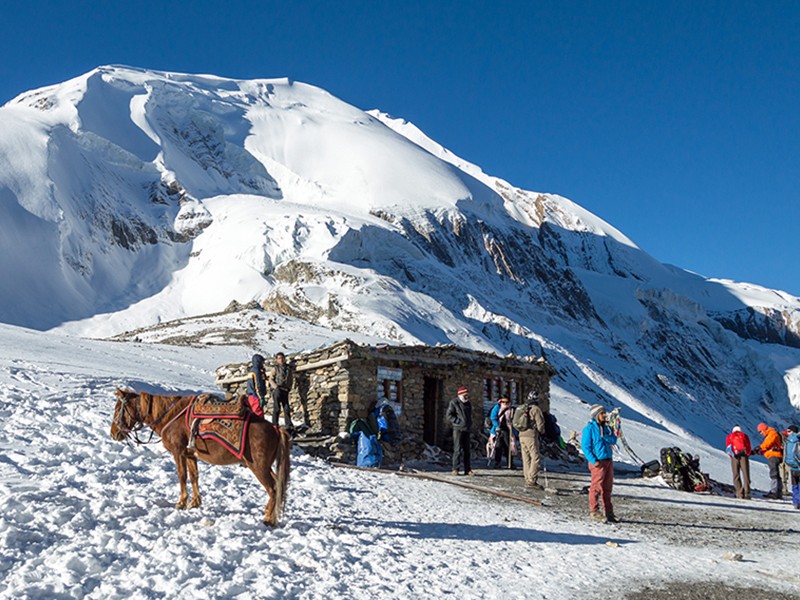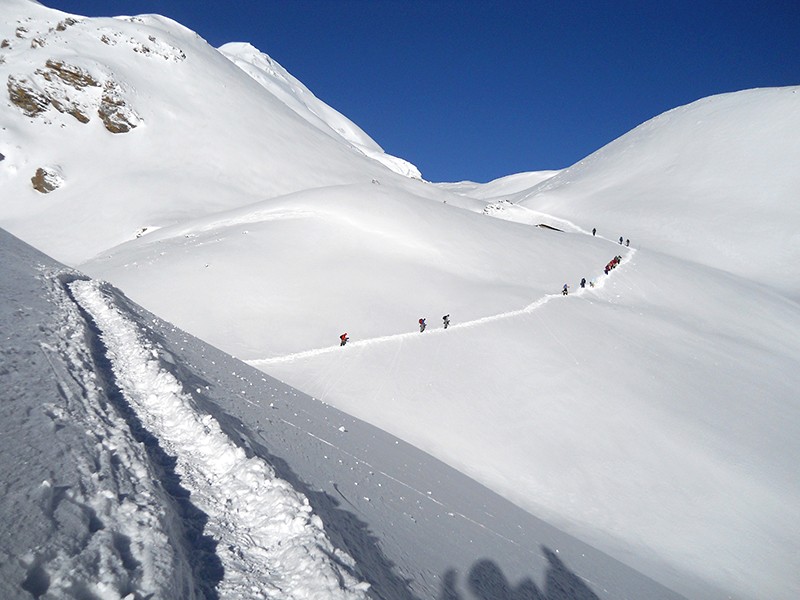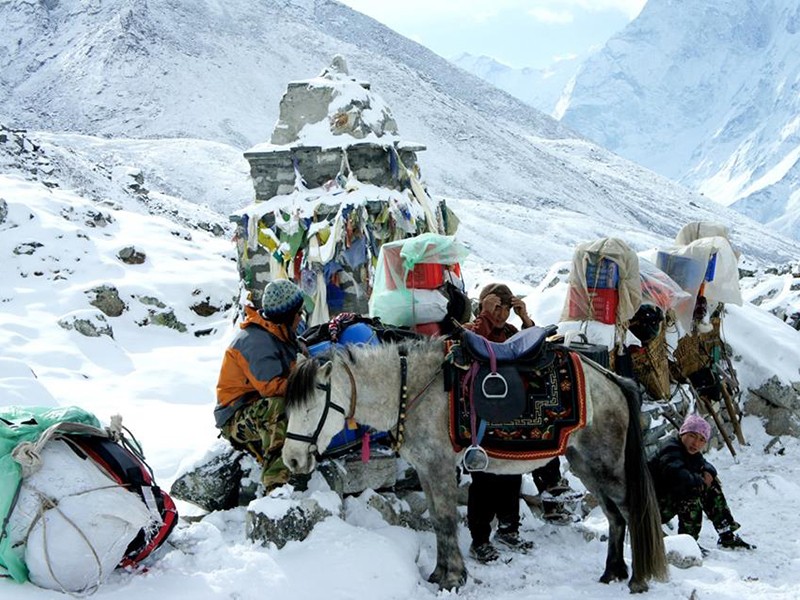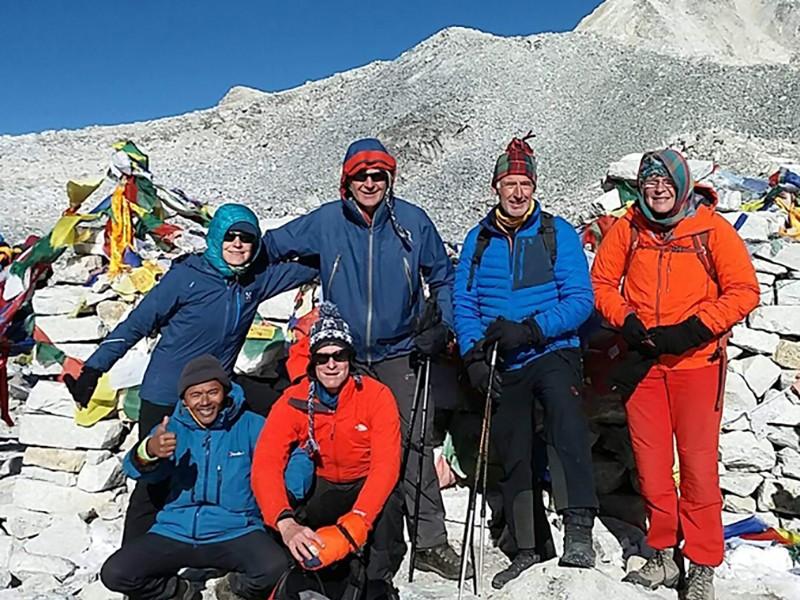Reference Code: RMACNP
Trip Start: Kathmandu
Trek Start: Soti Khola
Trek Days: 21 Days
Maximum Altitude: 5416m.
Age: 20 years to 60 years
Season: Spring and Autumn
Accommodation: Lodge
Service: Full board
Destination: Nepal
Trip End: Kathmandu
Trek End: Jomsom
Trip Durations: 28 Days
Physical Rating: Strenuous
Group Size: 4-16
Theme: Walking and Observation
Meals: Standard
The Round Manasulu and Annapurnacircuit is one of the best remote trekking area in Nepal. The most prominent of the peaks are Baudha himal, Gorkha Himal and Himal Chuli. the area is bordered by two major river systems .to the east Budhi Gandaki and to the west Marshandi Khola. Most attraction of this treks are the views of the Manaslu range and the Annapuna ranges and the forest and bird life along the ridge. The course starts from Gorkha. The ancestral seat of the reigning Shah dynasty, and the temple of Manakamana, one of the most popular pilgrimage sites for Hindu devotees. The route follows the rugged gorge of the Budhi Gandaki river through wild Gurung country. As the land rises the people change to more Tibetan-influenced Bhotia, and the first of many extensive mani walls appears before crossing the Larkya pass. It is one of the easier high passes in Nepal. But heavy snow can make the route difficult especially on the western side where deep snow drifts are likely to be found. Another part of this trek, Annapurna area is the most popular trekking region in Nepal, every year visited by 70 percent of trekkers, and for good reason. the deep valleys and high mountains encircling the giant Annapurna himal embrace a wide range of peoples and terrains, from subtropical jungle to a geographic extension of high, dry , Tibetan Plateau. The scenery is superb mix of lush vegetation, mountain peaks and an endlessly changing procession of people.
Day 01 Arrival in Kathmandu and transfer to hotel
Namaste! And welcome to Kathmandu, the colourful capital of Nepal where ornately carved balconies mingle with beautiful shrines and temples. Your adventure begins with a welcome meeting on arrival at the exit gate of Kathmandu airport. Our staff will welcome you and pick you to your accommodated hotel. Please seek our company palmplate to find our staff at the main exit gate of the airport. Rest of the day you can relax at the hotel or short evening walk around local market on your own as per your wish.
Day 02 Rest and preparation day
A well deserved rest day at cosy of hotel after a long tiring flight. This day, one can move around nearby local market to purchase or hire trekking equipment that is necessary for the trekking like sleeping bags, walking sticks etc, exchange currency as requirement or simply walk around in the local market or Kathmandu Durbar squire nearby with small entrance fee as per your preference on your own. Evening at the hotel lobby there will be pre-trip briefing in which you will be introduced with your trekking guide and explained about your trip in short, instruction for safety etc
Day 03 Drive to Arughat and then to Machha Khola(890m.)
Early morning, driving in the Prithvi Highway; occident from Kathmandu, we will be exceeding by a beautiful river view of the Trishuli river. From Dhading Besi, we will be driving to Arughat where the roads will be boisterous. After an early forenoon breakfast, we will be prelude our tour with a scenic drive to Arughat, ensuing to Soti Khola. Arughat being a huge settlement, it is aggregate on both sides of the Budhi Gandaki river connected by a suspension bridge. The next two hours' drive will take us to Machha Khola. In the first few hours, we will reach Dhading Besi which is the district headquarters of Dhading (1050m). Manaslu and Ganesh Himal range, small villages following the Budhi Gandaki river. Along the way we will see elegant mountain scenery resembling Mt. In this long drive, we will be stopping for multiple breaks and for lunch as well.
Drive hours 8-9 hours
Day 04 Trek to Jagar(1340m.)
Today our trail gets some ups and downs which often drops onto the gravel bars alongside the stream. The trail does become a little resistant at some point. Soon after, we will be crossing the Tharo Khola which flows in a rocky cavetto reaching Khorla Besi. Peaks like Manaslu Himal, and Kutang Himal are seen as they beautifully stand their ground. Khorla Besi is a small beautiful Gurung village and is a part of many trekking routes such as the Manaslu Circuit journey and the Tsum Valley trek. After another steep climb, we will reach Tatopani; hot Spring. Then we climb over a wrinkle, crossing the Budhi Gandaki river over a suspension bridge followed by a wide, well-made staircase over a ridge to Doban. It is a confluence of the ShiarKhola and the SarpuKhola that flows from the eastward and the occident.
4-5 hours
Day 05 Trek to Philim(1570m.)
Today, our travel age originate with thwarting a delay overbridge successive the eastwards embank scansorial a ragged hard imposition. In approximately, three hours of trekking, we come at Jagat from Doban. Jagat is the item setback item of the Manaslu Conservation Area. As we abide journey, the drag is solemn as it is paven and has unbounded flagstones and mani bulkhead that front flatly fine. This evince an symptom of the Tibetan Buddhist educate. After we fretful Jagat, the imposition fall us down to the Dudh Pokhari Khola. We will be interrupting the unfeeling abrupt to a ground of Salleri; the fields of rice and millet. Climbing along the occident escarp of the Budhi Gandaki affluent, we will be wonder by a celebrated prospect of the gleam apex of Singri Himal and Langju Himal to its orientate. Shortly, we will expanse the thorp of Sirdibas. In honest approximately forty-five jot up the procession is Philim; another huge Gurung village.
5-6 hours
Day 06 Trek to Deng(1860m.)
Today it will be a tender and a pleasant view of the naturalness trek from Philim. The snow capped trail will be engross us with impressive waterfalls on either side of the valley. As we poll towards the northward, traversing the terraced fields to Ekle Bhatti. We enter a steep, deserted gorge and then we descend down to the grasslike land incline with lofty pine trees thwarting the Budhi Gandaki overbridge. As we travel along the west bank, we will see the Shar Khola and the Tsum Valley that connect the Budhi Gandaki on the opposite bank. The trail takes us to the western side where the valley ultimately widens and we have a pleasing walk through the bamboo sylvan to Deng.
4-5 hours
Day 07 Trek to Ghap(2250m.)
Today, we will escalade up to Bihi Phedi stepping the Sringi Khola that promontory westward up the Budhi Gandaki. As we attend the imposition upstream of Deng affluent, we will be coming across a littletown include of four dwelling. As we persevere our travel with furthermore elevated scale and upwards and downs in the woodland, we will care a course with mani partition and chortens that precedence us to Ghap. This is a omen of Tibetan Buddhist educate. The mani partition in Ghap has an richly ornamental sculpture that compel it seem so delightful and absorbing. The educate lifestyles and the tribe in Ghap are fully selfsame to the Tibetan lifestyle
4-5 hrs
Day 08 Trek to Namrung(2660m.)
Today, we will take the march via the Prok town. This town is a surprising standpoint for a few point such as the SiringiHimal. It gives an astonishing sight and trekkers often restrain in this town for a while to seizure this consideration. We pass underneath a capacious overhanging cliff, and misfortune the Budhi Gandaki a few clock ensuing the tree radiate in a sylvan that have fledgeling and animals intercept Danphe or pheasant; Nepal’s public fledgeling and a group of grey Langur marmoset. We will also be pedestrian through a unmixed forest of fir tree, flowering rosebay and bamboos eventually gain Namrung through a stone archway. Namrung is an elegant dorp with a graphic struggle of buildings where we overnight.
4-5 hrs
Day 9 Trek to Lho(3180m.)
Today, we oblique the stiff overbridge over Budhi Gandaki as we chase the footway lined with household that are broadcast with cultured fields. As we begin the upper Nupri, the idiom changes to Tibetan. The pursue have mani rampart which an beautifully carven as the Tibetan educate stands out. We journey through woodland of firs, rhododendrons and oaks, promptly after, exceeding through a stone arch and entering the Lihi exhibit; the extraordinary workmanship of this neighborhood. As the exaltation grow, our trekking with appearance of pry like Mt. Manaslu and Naike Peak (5,515m). Shortly, we will cross a small stream that will lead us to Lho. Lho is a major league settlement with a monastery, a rough cobble archway at the entrance and chortens and immense mani wale denoting the Tibetan civilization.
5-6 hrs
Day 10 Trek to Samagaon(3530m.)
Leaving Lho today we’ll be enjoying the surprising survey of many mountains on the passage. We will be excessively the torpidness gate and a long mani testicle bailey of the clachan as we get to see the Ngadi Chuli; Peak 29 (7,879), Hiunchuli (7,893m) forth of us in Shyala village. after Shyala, the passing takes us up and easily after down to the affluent that originates from the glacier of Pungyen. Following the side moraine of the Pungyen glacier, we vanish through many chortens and monasteries with enormous prayer compass. The hiking gradually increases and becomes challenging as we cross the crest and trek in and out of the gulch of Thosang Khola. Descending down into a rock-strewn moraine across the defense, we emerge into an edge that examine the widespread fields of Samagaon where we overnight.
4-5 hrs
Day 11 Rest day at Samagaon for AMS
In this long journey, we acclimatize at Samagaon to adjust to the thin air as we are in a higher elevation. We will not stay idle but will explore this village of Buddhist culture. We will be noticing the lifestyles of the locals and experiencing their culture. Additionally, we have other explorations planned as well. The options include to hike to the Manaslu Base Camp or continue to Birendra Lake and then climb the ridge to Pungyen Monastery. This monastery is in the south of Samagaon which is about two and half hours’ hike. It is hidden behind the ridge in front of Manaslu and gives us tremendous view of the glaciers. Birendra Tal is a glacial lake at 3,450m where ice blocks tumble into the lake with thunder displays. Samagaon is indeed an interesting place for acclimatization.
Day 12 Trek to Samdo(3875)
Today the trek is comparatively more interesting and pleasant. We will be crossing the pasture areas and ascending to the valley. The trail leads us to forests with juniper and birch where we enjoy the eligence of the nature. As we reach down the Budhi Gandaki river, we will be crossing the wooden bridge over it and climb up steeply across the river. We will be getting an amazing view of the mountains, specially Manaslu as we will be reaching Samdo, which is a Tibetan refugee village. Upon reaching Samdo, we will also explore the village and the surrounding hills
3-4 hrs
Day 13 Trek to Dharmasala(4480m.)
With an thrilling day ahead, we walk down the edge through fields and old mani walls, crossing the wooden bridge over the Budhi Ganadaki river. We begin walking upward of the valley. We will be noticing the mani walls and the prayer flags hung on the route, signifying the closeness of the Larkya La Pass. After crossing two streams, we will witness the Larkya Glacier which is unquestionably magnificent. As we enjoy the view, we further trek around the valley of Salkha Khola and climb up again reaching the stone guest house (4,450m). The stone guest house is not a lodge but it is a kind of shelter better known as Dharamsala or Larkya La Phedi. Today’s day would be a gratifying day as we will get an amazing view of the Larkya Glacier and the amazing view of Mt. Manaslu in a great angle. The short trek today gives us plenty of time later onwards to acclimatize and relax.
3-4 hrs
Day 14 Trek to Bhimthang(3720m.) by crossing Larkya La (5160m.)
The dramatic and electrifying part of the journey awaits ahead for us, as we will be trekking around the Manaslu circuit crossing the Larkya La Pass (5,160m). After an early morning breakfast, we will leave Dharamsala as it will be a whole day trek. The weather being the most important factor, it will decide if the trek becomes more challenging as strong winds and a storm could possibly occur. We being by crossing the moraine, descending down to a small lake. The trail begins to be rough and unclear as we have to cross the south of steep grassy slope. Our route stays on the moraine to an edge which is marked by two landmarks. The prayer flags mark that the route is visible, so that we can continue trekking. Carefully trekking, we will descend to four frozen lakes then finally climbing a steep trail to the pass. The four frozen lakes look undeniably striking. From the pass, we get outstanding panoramic views of Himlung Himal, CheoHimal, Kang Guru and the great Annapurna II. As we live in the moment and admire the beauty of the nature, the trail takes us to the top of the moraine, heading to the west and making a steep, rough bends. We further cross the moraine then descend gently to another grassy moraine at 4,450m. As we have descended, the trail becomes easier to walk in and then we reach a small meadow. The valley begins to widen as we near the large meadow, mani walls and small houses that indicate we have reached Bhimthang
7-8 hrs
Day 15 Trek to Goa(2550m.)
After a long formal challenging walk, the pursue begins to variegate to the crystal current and the promontory water of the Dudh Koshi river. We will be contradicting the wooden bridge then through a dense pine sylvan where we will get a sight of the blooming rhododendron flowers with a diversity of ensign. This is flower versed at leap. Wide range of animals and birdwatch are seen in the sylvan as well such as sheep, horses, jackanapes etc. We then trial a landslide making a precipice escalade on to an edge ornamented with prayer flags. Above the Marsyangdi bottom, we can see the culminate of the mountain, Lamjung. After a perambulate to the river bank, we will lastly arrive at Goa where we overnight.
4-5 hrs
Day 16 Trek to Chame(2713m.)
Entering a Dence forest, cross over the bridge over tributaries and shortly afterwards near the foot of the water fall , climb steep stone steps . just beyond these up to Chame in about three and half hour. Good views of Annapurna. The lower part of the Chame is the administrative centre of Manang district. The upper part mainly inhabited by Tibetans. There is a hot spring just below this upper section.
Day 17 Trek to Lower Pisang Village(3200m.)
Leave the upper village of Chame on the left flank follow the path in the pine forest and climb along the river repeating ascents and descents till Bhratang. From here crossing suspension bridge you will reach Manang valley. A speculates Rockwell is in view for much of this climb.
3hrs
Day 18 Trek to Manang(3340m)
Today, we can enjoy a wonderful view of Annapurna Himal. It is the viewing day on the Marshyangdi trail till Hongde which has an airfield. The road leading to Manang becomes wider. Houses are built crowded together and a white Gompa stands above them all, contrasting with the dark walls of the houses. You will see Manang on the terrace in front of us. From here we enjoy the view of Gangapurna to the right of the glacier and Annapurna to the left. The trail is quite busy with many trekkers contrast to Manasulu region.
6-7 hrs
Day 19 Rest day for AMS
This is very important day for acclimatization before we get to high altitude again. There are plenty of good day hikes in this area. It is a proper Bhot valley. It lies in the confluence of river Marsyangdi and Thorang khola. On both side of valley-north and south –high Himalayan ranges are stretched continuosly from east to west of Manang. It falls in the rain shadow area of Annapurna range, where less than 300mm of annual rainfall occurs, most of which falls in the form of snow. This bhot valley is regarded as the coldest snow desert of Nepal. This day if we feel strong, we can hike to Gangapurna Lake or to Braga Monastery.
Day 20 Trek to Yak Kharka(4050m.)
Today, we walk through the dark colored houses of Manang and follow the path of stone walls and sandy trail. We will arrive to Yak Kharka or Koche village. Koche is the place famous for grazing animals. In the pasture land grasses and varieties of seasonal flowers are found. It has glacier and other water resources. It makes this place very attractive.
3-4 hrs
Day 21 Trek to Thorung Phedi(4450m.)
This day, the trail continues towards to remote throng phedi where we will not see any trees around here. Later we gradually climb uphill towards to base camp. Thorung phedi is a small hamlet situated near the Marshandi river. It is situated at an altitude of 4450m. just below the settlement, there is a big pasture land. All the other surroundings area are naked and snowy mountains.
4 hrs
Day 22 Trek to Muktinath(3760m.) by crossing Thorung La(5416m.)
Today is the most difficult day of the trek and highlight section of this course. It is going to be long journey and it is wise to leave early in the morning. The trail continues uphill all the way to Thorong La (5416m.) where you can see stone hillock with flapping prayer flag. As soon as we cross Thorong La, trail start to descend steeply all the way to Muktinath, the green, sacred land for Hindus and Buddhist.
8-9 hrs
Day 23 Trek to Jomsom(2720m.)
Today our trail begins over dusty and windy vehicle road. If we don't wish to walk on this trial then we can take local sharing jeep to Jomsom. Jomsom is the biggest village in this area with high altitude airport supporting people of this area. Jomsom is also very famous for organic apple and apple cider. This is the last day of our everlasting trek where we celebrate the success with Adventure Zambuling staffs.
Day 24 Fly to Pokhara(820m.)
Early morning we take 25 minute flight to Pokhara where we can see the last eagle eye glimpse of Annapurna range. On arrival we will drive to hotel where we take rest after long trek earlier. Evening we can walk around the Phewa lakeside and local market around.
Day 25 Exploration day in Pokhara
Pokhara is a place of remarkable natural beauty. Situated at an altitude of 820m from sea level and 200km west of the Kathmandu Valley, Pokhara city is the most popular tourist destination in Nepal. This enchanting city, with a population of around 95,000, has several beautiful lakes and offers stunning panaromic views of the Himalayan peaks. The serenity of lakes and the magnificence of the Himalayas rising behind them create an ambience of peace and magic. Pokhara city is also the starting point for many popular treks in Nepal.
Pokhara is part of a once vibrant trade route extending between India and Tibet. To this day, mule trains can be seen camped on the outskirts of the town, bringing goods to trade from remote regions of the Himalaya. This is the land of Magars and Gurungs, hardworking farmers and valorous warriors who have earned worldwide fame as Gurkha soldiers. The Thakalis, another important ethnic group here, are known for their entrepreneurship.
The climate of Pokhara is slightly warmer than Kathmandu with daytime temperatures of around 15 degrees Celsius in the winter and 35 degrees in the summer.
Sarangkot
The view of the Annapurna Himalaya from Sarangkot is almost a religious experience. From here, we can see a panoramic sweep of Himalayan peaks, from Dhaulagiri (8167m) in the west to the perfect pyramid that is Machhapuchhare (6997m) and the rounded peak of Annapurna II (7937m) in the east. Most people come here at dawn or dusk, when the sun picks out the peaks in brilliant colours.
Fewa lake, the second largest lake of Nepal, is the center of attraction in Pokhara. It is the largest and most enchanting of the three lakes that add to the resplendence of Pokhara.
Mahendra cave
Another of nature’s wonders in Pokhara is the Mahendra Gupha(Cave). This large limestone cave is locally known as the House of Bats, an apt name for it. A two-hour walk to the north of Pokhara, it is best to bring your own torch to see the stalactites and stalagmites, as well as the local winged residents.
Seti River
Another of Pokhara’s natural wonders that unfailingly interests visitors is the Seti river. Flowing right through the city, this river runs completely underground at places. Amazingly, at certain points the river appears hardly two meters wide. But its depth is over 20 meters! Mahendra Pul, a small bridge near the old Mission Hospital, provides a perfect view of the rivers’s dreadful rush and the deep gorge made by its powerful flow.
Barahi Temple
The Barahi temple is the most important monument in Pokhara. Built almost in the center of Phewa Lake, this two-storied pagoda is dedicated to the boar manifestation of Ajima, the protectress deity representing the female force Shakti. Devotees can be seen, especially on Saturdays, carrying male animals and fowl across the lake to be sacrificed to the deity.
Museum
The Pokhara Museum, located between the bus stop and Mahendra Pul, reflects the ethnic mosaic of western Nepal. The lifestyles and history of ethnic groups such as the Gurung, Thakali and the Tharu are attractively displayed through models, photographs and artifacts. One major attraction is a display highlighting the newly-discovered remains of an 8000-year-old settlement in Mustang.
Adventure Activities:
Pokhara also provide opportunity for various adventurous activities like ultralight flight, Para jumbing, Zip flyers etc.
Day 6 Fly/Drive to Kathmandu
If we take ground transportation then it will take around 7-8 hours drive through Prithivi Highway and Tribhuwan Highway along the river bank of Marshyangdi River and after Muglin along the river bank of Trisuli River.
If we take air transportation then we take afternoon 28 min flight to Kathmandu.
Day 27 Rest and final shopping day
This is the final day in Nepal. A chance to do some shopping, explore at leisure or merely relax by the hotel. We enjoy a final night together, reliving the trek and our extraordinary achievements.
Day 28: Final departure
We say 'Namaste' for memories that will last a lifetime. There are no activities planned for today and you are able to depart the hotel at any time. Check out time from the hotel is at 12 noon. If you are departing later, you can arrange luggage storage at the hotel. For your final departure, our staff will pick you up from the hotel and transfer to Kathmandu airport approximately 3 hours prior to your international flight time.
Inclusion
Lodge basis
All ground transportation as per itinerary
Domestic flight from JOM-PKH-KTM with airport tax
4 night hotel accommodation in Kathmandu with B/B plan.
2 night hotel accommodation in Pokhara with B/B plan.
TIMs (Trekking Information Management system) card
MCAP and ACAP Fee
Special Restricted Area Permit Fee for Manasulu
Food for the member during the trek( 3 meals a day as per lodge open menu)
Lodge accommodation on twin sharing basis
All required Nepalese staffs
All Nepalese staffs insurance
Company service charge,VAT and government taxes etc.
Exclusion
International flight with airport tax.
Nepalese Entry Visa fee
Food during stay in Kathmandu
All personal equipment and personal expenses
Photography Charges, Monument charges and Monument entry fees
Personal Medical and travel insurance(must cover helicopter rescue evacuation cost)
Personal Medicine
Telephone and internet charges
Laundry charges
Alcoholic beverage, bottled drinks and cold drinks during the trip
Rescue evacuation charges if required
Staff and porters Tips...
Equipment List
Clothing and Equipments List
» Pack to pack out - bring enough waterproof bags to carry all non-biodegradable rubbish back down the mountain.
» Remove all unnecessary packaging before leaving home.
» Bring enough warm dry clothes so that you can wrap up rather than burn firewood in the evenings.
» If you are going to trek higher than 5000m or you know it will be cold, buy an aluminum water bottle which can also be used as a hot water bottle at night.
» The easiest way to keep hydrated while trekking is to buy a 1 x liter platypus-drinking bladder to carry in your day pack.
» Make sure to buy proper trekking socks. Don’t buy synthetic socks as these promote sweating and can give you blisters. Always carry a few blister pads in your first aid kit and keep them handy in your day pack.
» Walking poles are very useful while trekking and helpful when descending.
» Please remember that waste disposal and recycling facilitates are limited in Nepal. When buying batteries make sure they are rechargeable and/or high quality so they last longer, and take them home to recycle.
More Lists
There is no definitive list. What you bring will vary according to the area, time of year and the length of your trek. Below is a suggested check list which you should adapt to your own needs. Ask yourself: Will there be snow/how long /high is the trek/are we camping?
» Good quality trekking boots with ankle support
» Lightweight shell/raincoat with hood
» Detachable fleece liner or separate fleece
» Fleece trousers
» Shorts and / or convertibles trousers- quick drying
» Sunglasses
» Sun hat and warm hat(good quality)
» Gloves
» Spare T-shirt x 3
» Sweat towel x 2
» Spare socks x 3 ( walking sock and thin inner sock)
» Small day sack
» Sun cream
» Small water bottle aluminum doubles as a hot water bottle.
» Iodine or water purifying kit,
» Soluble vitamin tablets to taste water or powder fruit drink
» Talcum powder
» Walking sticks or Trekking poles(good quality)
» Camp shoes/trainers/flip flops to wear in evening.
» Spare underwear 3
» Toilet kit
» Tissues
» Pen knife
» Bum bag
» Head torch(good quality)
» Biodegradable washing liquid / soap
» FILM
» CAMERA
» Ear plugs
» Sleeping bag liner(good quality)
» Sleeping bag(good quality-30)
» Bin bag/ gasbag to keep kit dry
» Small towel
» Lip balm
» Available in KTM
Personal First Aid (Aids Kit)
» Antiseptic
» Bandages
» Blister plasters
» Decongestant
» AMS medication like Diamox
» Eye drops – it can get very dusty on trails
» Paracetamol and/or ibuprofen
» Rehydration sachets, Imodium and antibiotics for traveler’s diarrhea
» Scissors
» Sterile dressing
» Sticking plasters and tape
» Throat lozenges / sweets
» Tweezers
» A sewing needle etc.
This trekking equipment list has been prepared by Adventure Zambuling Treks (P) Ltd.
